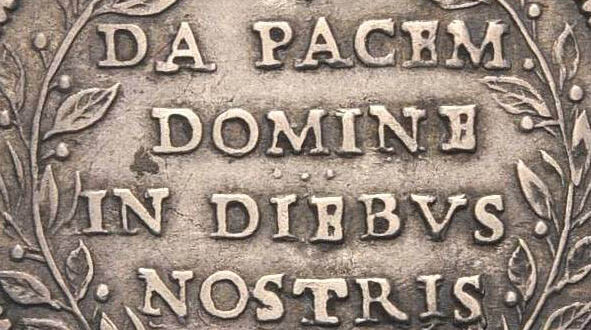Introduction: A Song That Spans the Centuries
In times of war, social tension, ideological polarization, and inner anguish, the human heart lifts a plea that resonates from the depths of Christian history: Da pacem, Domine. “Grant peace, Lord.” This simple yet powerful phrase, turned into a liturgical chant and prayer, has been sung by monks, priests, and believers of all ages—from medieval abbeys to modern cathedrals. But today, in the twenty-first century, what does asking God for peace really mean? What kind of peace are we seeking? And how can we live and sow that peace in an increasingly wounded world?
This article invites you to discover the theological, spiritual, and pastoral richness of the chant “Da pacem Domine,” exploring its origin, scriptural foundation, contemporary relevance, and how it can become a real spiritual compass in your daily life.
1. The Original Latin Text and Its Translation
Da pacem, Domine, in diebus nostris,
quia non est alius,
qui pugnet pro nobis,
nisi tu, Deus noster.
Translation:
Grant peace, Lord, in our days,
for there is no other
who fights for us,
but You, our God.
This chant, brief but intensely profound, captures the cry of a humanity aware of its fragility and the impotence of merely human solutions to conflicts of soul and world. It is a humble acknowledgment that only God can grant us true peace.
2. Biblical and Patristic Origins of the Chant
Although the text of Da pacem Domine is not directly drawn from a single biblical verse, it is inspired and constructed on the basis of several passages from the Old Testament, especially the Book of Psalms and the prophecy of Jeremiah:
“Grant peace, O Lord, to those who wait for you, that your glory may dwell in our land” (cf. Sirach 36:18).
“Pray for the peace of Jerusalem: ‘May those who love you prosper’” (cf. Psalm 122:6–8).
“They have healed the wound of my people lightly, saying, ‘Peace, peace,’ when there is no peace” (Jeremiah 6:14).
The latter verse is particularly revealing. The prophet Jeremiah denounces false prophets and leaders who promise a superficial, apparent “peace,” while sin, injustice, and idolatry continue to destroy the people from within. Hence, Da pacem Domine is not a simple plea for the absence of war, but for true peace—one that springs from the heart of God and a life reconciled with Him.
3. Liturgical History of the Chant
The Da pacem Domine has a venerable history in Christian liturgy, especially in the Mozarabic rite and the Gregorian tradition. It was frequently chanted during the celebration of the Holy Mass in times of war or persecution, and has also been included in processions, litanies, and moments of communal or personal prayer for peace.
During the Middle Ages, it became a favorite chant in monasteries, where contemplative life was united with a deep desire to intercede for a divided world. Today, it remains part of the liturgical repertoire of many religious communities and ecclesial movements praying for world peace.
St. Augustine wrote:
“True peace is the tranquility of order, and that order is what God establishes.”
(City of God, XIX, 13)
4. Theological Dimension: What Peace Are We Asking For?
Christian theology clearly distinguishes between worldly peace and God’s peace. Jesus Christ expressed this very clearly:
“Peace I leave with you; my peace I give you. I do not give to you as the world gives.” (John 14:27)
Christ’s peace is not a mere absence of conflict, nor superficial conformity. It is a deep reconciliation of the soul with God, an interior harmony that allows the Christian to withstand external storms without losing direction.
In theology, peace is one of the fruits of the Holy Spirit (cf. Galatians 5:22), and therefore inseparable from a life in grace, a clean conscience, and radical openness to the divine will.
The plea “quia non est alius qui pugnet pro nobis”—“for there is no other who fights for us”—resonates with powerful Christological meaning. It reminds us that Christ is our only Mediator, Savior, and Prince of Peace (Isaiah 9:6). He conquered sin, death, and the devil on the Cross. Therefore, without Him, there is no true peace.
5. Practical Applications: Living “Da pacem Domine” Today
a) Peace with God
The first peace we must seek is peace with God. This is primarily done through the sacrament of confession. A reconciled soul is a soul at peace. St. Josemaría used to say: “Peace is the outcome of interior warfare, of spiritual struggle well conducted.”
b) Inner Peace
Anxiety, fear, stress… are modern maladies often rooted in spiritual causes. The prayer of Da pacem is also a prayer of liberation: “Lord, fight in my interior. Be my shield. Grant peace to my restless soul.”
Practical tip: Repeat this prayer as a short invocation in moments of distress: “Da pacem, Domine.”
c) Peace in the Family and Society
There is no peace in the world if there is no peace in the heart, and no peace in the heart if there is no forgiveness. Da pacem Domine can become a school of reconciliation. Examine if there are people you need to ask forgiveness from or reconcile with. Invite your family to pray together for peace—not as an abstract concept, but as a concrete reality beginning at home.
d) Peace Among Nations
While many wars are beyond our control, as Christians we are called to be “peacemakers” (Matthew 5:9). This includes:
- Not fostering hatred or political polarization.
- Praying for leaders and countries at war.
- Supporting humanitarian or refugee aid initiatives.
- Being prophetic voices against injustice.
6. The Chant as a Living Prayer: A Spiritual Proposal
Here’s something concrete to try: for one week, at the beginning or end of your day, chant or recite slowly this hymn:
Da pacem, Domine, in diebus nostris,
quia non est alius,
qui pugnet pro nobis,
nisi tu, Deus noster.
Do it in silence. Meditate on each word. Then, in your personal prayer, tell God the conflicts you need Him to fight for you. He will hear you.
Conclusion: Peace, a Gift from Above
Da pacem Domine is not a museum piece or a forgotten medieval chant. It’s a cry still alive in every soul thirsty for serenity, justice, reconciliation, and God. Amid a world at war—externally and internally—this chant reminds us that only Christ can grant us a peace the world doesn’t understand and cannot steal.
Therefore, with humility and trust, let us once again raise this millennial plea as though it were new:
“Grant peace, Lord, in our days,
for there is no other who fights for us,
but You, our God.”
Suggested Final Prayer:
Lord Jesus, Prince of Peace,
look upon our world wounded by violence,
our divided families,
our agitated hearts.
Grant us peace, Lord,
that peace the world cannot give.
Make us instruments of your peace.
Fight for us,
for without You we can do nothing.
Amen.






